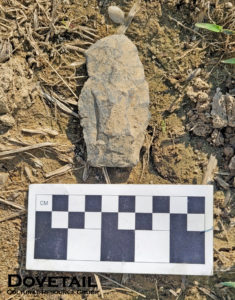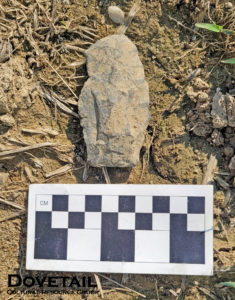By: Andy Martin
This Fox Creek or Selby Bay (if you’re from Virginia) projectile point was recovered from the John Dickinson Plantation in southern Delaware.
Why is this extra cool?
Fox Creek/Selby Bay projectile points are a relatively common point type that are usually dated from 1,800 to 1,100 BP, or 1,800 to 1,100 years ago. This places Fox Creek/Selby Bay points squarely in what archaeologists call the Middle Woodland period. The Middle Woodland was a time period that would have seen pretty similar environmental conditions to those we have today, and the Pre-Contact peoples of Delaware would have been spending more of their year in larger settlements and generally moving around less. The Middle Woodland tool kit reflects this change too, with a greater emphasis on ceramics for storage and cooking. But at the same time as people were becoming more sedentary, as reflected by diagnostic Middle Woodland artifacts like ceramic pots, other parts of their tool kit, like our Fox Creek/Selby Bay projectile point, show how their trade networks were expanding.
This projectile point is made from a high-grade argillite, which is significant because argillite is most commonly sourced from the Lockatong Formation, a band of stone outcrops that begins in what is now Pennsylvania and New Jersey, between 60 and 90 miles from the John Dickinson Plantation. This fits a broader pattern of Middle Woodland sites, where non-local tool stones are becoming more and more common. That’s what makes this projectile point more interesting than it might initially appear. These stone tools made from non-local, or ‘exotic’ sources are evidence that, at the same time as people were becoming more sedentary, their worlds, or at least their trade networks, were are also expanding.

Fox Creek Projectile Point Recovered From John Dickinson Plantation.
But wait, there’s more!
The fact that our point is made of argillite is in some ways more significant because of the Pre-Contact sites that are adjacent to the Lockatong formation, sites like….Abbot Farm. Abbot Farm is probably best thought of as concentration of large Pre-Contact sites located at the confluence of the Crosswicks Creek and the Delaware River in Trenton New Jersey, roughly 80 miles upriver from the John Dickinson Plantation. The sites at Abbott Farm date to at least the Archaic Period (beginning 10,000 years ago) on through to the Late Woodland period (ending with European contact circa 400 years ago), but we mention Abbot Farm because not only is it close to a very large argillite source, but because excavations at Abbot Farm have shown that the area is home to a lot of Middle Woodland pre-contact sites, and these sites are, in turn, loaded with argillite Fox Creek/Selby Bay projectile points.
Does this mean our Fox Creek/Selby point came from Abbot Farm?
Not necessarily, and there’s no way we can prove that or would make such a claim, but what’s so fascinating about Abbot Farm is that the sites there have loads of exotic stone, some of which is from as far afield as modern-day western New York and the Great Lakes. So, what we’ve got here with our little argillite projectile point is a glimpse of an exchange network that potentially links southern Delaware to New Jersey and Pennsylvania, and those NJ and PA sites then potentially linked to sites in New York and along the Great Lakes.
See what we mean when we say that the world of the Middle Woodland was expanding even as its people were becoming more sedentary? That’s one of the beautiful things about archaeology, a single artifact can ‘point’ towards the way whole regions are changing, and in this case, becoming more connected.
Any distributions of blog content, including text or images, should reference this blog in full citation. Data contained herein is the property of Dovetail Cultural Resource Group and its affiliates.

